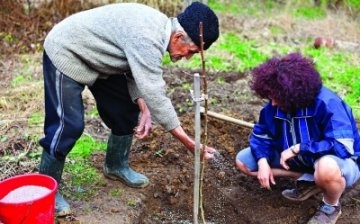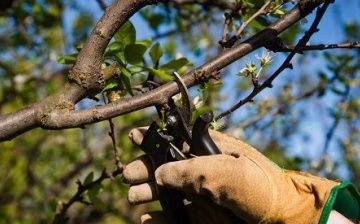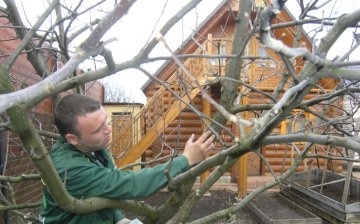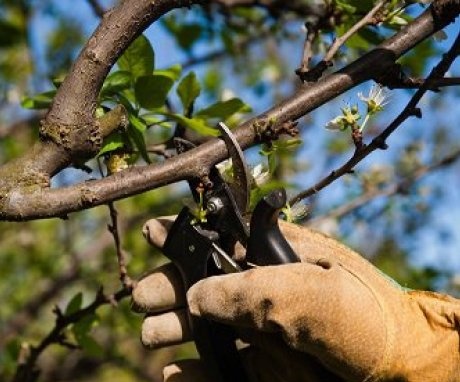Planting cherries in spring: technology, care rules, possible problems
Cherries are planted both in spring and autumn. The main thing is that all growing conditions are met and the optimal temperature regime is selected.
Content:
Cherry planting technology in spring
Cherries are planted in spring in April, and in autumn no later than October. If the seedlings were purchased in November or later, it is better to wait for spring.
If the planting of cherries will be carried out in the Urals, Siberia or other regions with a harsh climate, then the events are held only in spring. Before the onset of cold weather, the plant should take root and get stronger.
Autumn seedlings need to be dug in, the technology is simple:
- You need to choose a place in a garden where there is little sunlight and the snow will last as long as possible.
- At this place, a hole is dug with a depth of about 40 cm.
- One side of the pit should be vertical, the other sloped.
- Saplings are laid on an inclined side, the roots and 1/3 of the trunk are sprinkled with earth.
- The seedlings are immediately watered well, it is necessary to achieve adhesion of the soil to the roots.
- So that in winter the seedling does not freeze and is not damaged by rodents, a shelter is made of pine spruce branches.
- At the onset of winter, the seedlings are covered with a large layer of snow.
The roots of the seedlings must be healthy. Damaged roots can be trimmed. If they have dried out a little, then they are soaked in settled water for a couple of hours.
Cherries will take root best. on sandy loam soil, the acidity should be neutral. You need to pay attention to the groundwater, under the cherry they should go as deep as possible.
For the spring planting of cherries, a pit is prepared up to 50 cm deep and up to 60 cm wide.
The straightened root system should fit freely into the pit. The cherry seedling is rather fragile, so a peg is installed in the pit for support, the young cherry can be simply leaned against the support, or it can be tied with soft material.
Fertilizer is placed at the bottom of the pit. It is made according to the following scheme:
- Superphosphate (30-40 gr)
- Potassium chloride (20-25 gr)
- Ash (1 kg)
- Clay soil can be lightened by adding a bucket of sand.
If planned plant some trees, then you need to keep a distance between them. If the variety is shrub, then adhere to 2 meters, 2.5 meters should remain between the rows. If the variety is tree-like, adhere to 3 meters, and between the rows - 2.5 meters.
Around the trunk, at a distance of 30 cm, a roller is made of the ground so that when watering, water falls directly under the trunk. Immediately after planting the tree, it is watered with warm water in the amount of 25 liters. The near-trunk circle is mulched with humus in a few centimeters. Sawdust, humus or crushed compost are used as mulch.
Cherry care
All cherry care activities are divided into:
- Loosening
- Timely watering
- Feeding
- Pest control
Loosening is done in spring and summer. This is done near the cherry tree trunk circle. The last time the soil is dug up in the fall to a depth of 20 cm.
Although cherries tolerate drought well, in dry weather it is better to water it... Watering is also provided during the ripening period of the fruits, this will help to increase yields.
The first three years of fertilization can not be applied, it will be enough to fertilize, which was introduced into the planting pit. Top dressing begins to be applied when the first fruits appear. Top dressing is applied in the fall, 70 g of potash fertilizer and 200 g of phosphoric fertilizer are used. In the spring, nitrogen fertilization is applied if necessary. Compost or manure can be applied every few years.
Fertilizer is applied separately during the growing season, this is done twice. The first one immediately after flowering, the second two weeks later.
Top dressing preparation scheme:
- Water (50 liters)
- Mullein (10 liters)
- Ash (1 kg)
Another recipe can be used:
- Water (10 liters)
- Superphosphate (25 gr)
- Potassium chloride (15 g)
- Urea (10 gr)
Cherry reacts extremely negatively to spring frosts, there is a risk of flower death. Therefore, in advance you need to take care of protecting the tree from the cold. Cherry blossoms can be pushed back a little so that they occur after frost. The soil is covered with a large layer of snow, on top of which mulch (straw or sawdust) is laid. The earth will begin to thaw a little later, so flowering comes later. The duration of such a delay is no more than 7 days.
The second way to protect cherries from frost is to smoke. Before the start of frost, dry manure, sawdust or straw are set on fire in several areas in the garden, the latter must be wet. The material should not burn, but smolder so that there is as much smoke as possible.
If, on the contrary, you need to attract the attention of bees, then cherry flowers are sprayed with a sweet solution. To prepare it, you will need a liter of boiled water and 1 tablespoon of honey.
Possible problems when caring for cherries
The most dangerous for cherries are two diseases: coccominosis and moniliosis.
Coccomyzosis is characterized by complete leaf abscission during the growing season. When a tree just starts to hurt, gray spots appear on its leaves. In order to prevent such a problem, it is better to pick up a strong variety in advance, namely: Shokoladnitsa, Studencheskaya, Rovesnitsa, Turgenevka, Kharitonovskaya.
Also, the rules for caring for the tree must be followed. There should be no weeds around the trunk (they are eliminated during loosening), when the leaves fall off they need to be burned.
At the first signs of the disease, the leaves are sprayed with copper-containing preparations, the most popular are Cuproxat, Abigo-peak and Hom.
Moniliosis is more serious illness... It manifests itself during the flowering period, flowers and leaves begin to dry out and fall off. The disease quickly destroys the tree. There is no cure for moniliosis; only prevention can save cherries. To do this, before and during flowering, the leaves are sprayed with Horus solution.
After flowering, a solution of Speed is used. Skor can save the tree in the early stages of the disease; after three treatments, the parasites recede. The tips of the shoots with affected leaves are removed by 10 cm and burned.
Other notable cherry diseases:
- Hole spotting is a fungal disease. In spring, brown spots with a dark edging appear on the leaves. Over time, the stains dry out and holes remain. Affected fruits also develop dark spots.
- Gum cutting is characterized by the formation of drying resin in the places where branches are cut and sunburned. On the trunk, the resin just dries up, and the branches can dry out and fall off.
- Fruit rot can be found in late summer during crop formation. The fruit becomes covered with a brown spot, fates with rot appear, spores are easily carried by the wind to other trees.
- A sooty fungus can be identified by the black bloom on the leaves. Fungus deposits can be removed mechanically.
- Rust attacks the leaves. Inflated areas of a red or orange hue appear on them.
Very often, small white worms live in the fruits of cherries and cherries, these are the larvae of a cherry fly. The tree cannot be insured against this parasite, it affects all varieties.The legless larvae feed on the pulp of the fruit, from which they become softer, ripen and darken faster. When the larva finishes feeding, it pupates in the soil, and the fruit falls off.
To prevent the reproduction of worms in cherry fruits, trees must be treated with a solution of Phosbecid, Karbofos or Furanon. This is done in late spring, but more than 20 days before harvest.
Some parasites are more dangerous, some less. Everyone can be easily dealt with if the problem is discovered in time. Cherry is a delicate tree, but despite this it's easy to grow it... If you follow all the rules for care, then there will be no problems.
More information can be found in the video.













